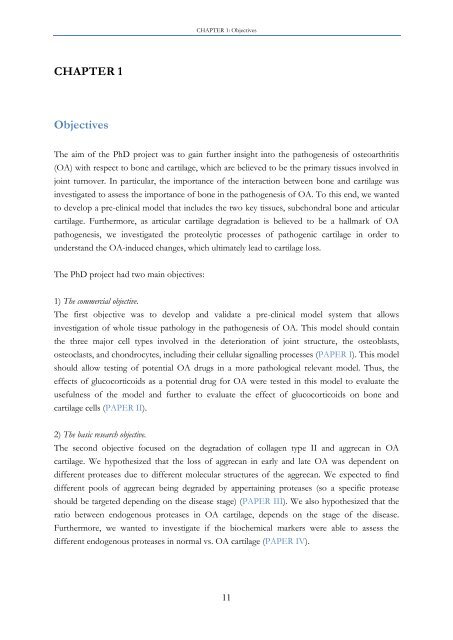Identification of important interactions between subchondral bone ...
Identification of important interactions between subchondral bone ...
Identification of important interactions between subchondral bone ...
Create successful ePaper yourself
Turn your PDF publications into a flip-book with our unique Google optimized e-Paper software.
CHAPTER 1<br />
Objectives<br />
CHAPTER 1: Objectives<br />
The aim <strong>of</strong> the PhD project was to gain further insight into the pathogenesis <strong>of</strong> osteoarthritis<br />
(OA) with respect to <strong>bone</strong> and cartilage, which are believed to be the primary tissues involved in<br />
joint turnover. In particular, the importance <strong>of</strong> the interaction <strong>between</strong> <strong>bone</strong> and cartilage was<br />
investigated to assess the importance <strong>of</strong> <strong>bone</strong> in the pathogenesis <strong>of</strong> OA. To this end, we wanted<br />
to develop a pre-clinical model that includes the two key tissues, <strong>subchondral</strong> <strong>bone</strong> and articular<br />
cartilage. Furthermore, as articular cartilage degradation is believed to be a hallmark <strong>of</strong> OA<br />
pathogenesis, we investigated the proteolytic processes <strong>of</strong> pathogenic cartilage in order to<br />
understand the OA-induced changes, which ultimately lead to cartilage loss.<br />
The PhD project had two main objectives:<br />
1) The commercial objective.<br />
The first objective was to develop and validate a pre-clinical model system that allows<br />
investigation <strong>of</strong> whole tissue pathology in the pathogenesis <strong>of</strong> OA. This model should contain<br />
the three major cell types involved in the deterioration <strong>of</strong> joint structure, the osteoblasts,<br />
osteoclasts, and chondrocytes, including their cellular signalling processes (PAPER I). This model<br />
should allow testing <strong>of</strong> potential OA drugs in a more pathological relevant model. Thus, the<br />
effects <strong>of</strong> glucocorticoids as a potential drug for OA were tested in this model to evaluate the<br />
usefulness <strong>of</strong> the model and further to evaluate the effect <strong>of</strong> glucocorticoids on <strong>bone</strong> and<br />
cartilage cells (PAPER II).<br />
2) The basic research objective.<br />
The second objective focused on the degradation <strong>of</strong> collagen type II and aggrecan in OA<br />
cartilage. We hypothesized that the loss <strong>of</strong> aggrecan in early and late OA was dependent on<br />
different proteases due to different molecular structures <strong>of</strong> the aggrecan. We expected to find<br />
different pools <strong>of</strong> aggrecan being degraded by appertaining proteases (so a specific protease<br />
should be targeted depending on the disease stage) (PAPER III). We also hypothesized that the<br />
ratio <strong>between</strong> endogenous proteases in OA cartilage, depends on the stage <strong>of</strong> the disease.<br />
Furthermore, we wanted to investigate if the biochemical markers were able to assess the<br />
different endogenous proteases in normal vs. OA cartilage (PAPER IV).<br />
11

















